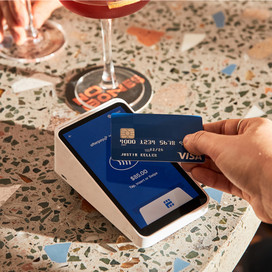Table of contents
Increasing numbers of businesses are working to move their customers onto a recurring billing model. With that in mind, here is a quick guide to what you need to know about recurring billing and recurring invoicing.
What is recurring billing?
Recurring billing is when merchants charge the customer at pre-agreed intervals. These intervals may align with when the goods or services are delivered. Recurring billing comes in two main forms, fixed billing and variable billing.
Fixed recurring billing
Fixed billing is when the customer is charged the same amount each billing cycle. For this to be possible, the merchant has to be confident that their costs will also remain fixed. This means that fixed billing is typically used when a customer requires a predefined order or goods or level of service.
Subscription billing is a specific form of fixed billing. In this approach, the merchant typically offers a predefined range of options. The customer simply chooses which one suits them best. They can change from one option to another but cannot define options themselves.
Fixed billing agreements are often time-limited. This gives the merchant an opportunity to review their prices. Where they are indefinite, the merchant needs to ensure that there is a mechanism for them to change their prices as necessary. This usually means giving customers notice of the price increase and allowing them to cancel if they wish.
Variable recurring billing
Variable billing is when the customer can be charged different amounts each billing cycle. That doesn’t mean they necessarily will be, but that the option is there. Variable billing generally comes in one of two main forms: metered billing and volume billing.
Metered billing is when a customer is charged according to consumption. For example, it is used by most utility companies. Volume billing, also known as quantity billing, is when a customer is charged per item or per user. For example, most online services use volume billing and base it on the number of user licences the customer needs.
Fixed and variable recurring billing
It’s very common for merchants to use a combination of fixed and variable recurring billing. Fixed recurring billing covers the customer’s predicted usage. Variable recurring billing covers any extras. This is exactly what mobile phone companies do with most contracts. Your monthly fee gets you an allowance of calls, texts and data, and if you go over this, you pay additional charges.
Recurring billing vs instalments
Instalment payments are a specific form of recurring billing. The key difference between instalments and standard recurring billing is that instalments are time-limited.
With instalment plans, the merchant essentially gives the customer a loan to buy their products or services. This is usually interest-free. Each time the customer makes an instalment payment, the amount they owe is reduced. When it is cleared, the payment stops.
What is recurring invoicing?
Recurring invoicing is when you invoice customers on a pre-agreed cycle. This may or may not align with the delivery of the goods or service, or the actual recurring billing.
For example, many companies invoice in the middle of month B for goods or services provided during month A. If the company offers 30-day payment terms, the customer will then be billed in the middle of month C.
In general, recurring invoicing tends to be used in tandem with recurring billing. Recurring billing can, however, be used without recurring invoicing, because a private customer generally doesn’t need or want invoices, but will need receipts.
When to use recurring billing?
If you’re providing goods and services on a recurring basis, it’s important to think about implementing recurring billing. If you’re not, then ask yourself if there is a way for you to do so. Even if recurring billing only forms a small part of your overall billing, it can still make your day-to-day noticeably easier.
Take a look at your sales data and look for patterns of repeat purchases. Then think about how you can leverage those into income streams you can charge through recurring billing. For example, if you sell office supplies, offer to send customers an ongoing supply of standard consumables (e.g. toner cartridges) and charge that using recurring billing.
There might be scope to provide value-added services alongside any products you sell. Even if you don’t want to transition to a full service business, this can be a useful way of generating additional regular income.
When to send recurring invoices?
If you’re sending invoices and using recurring billing, then you can send recurring invoices. In general, send these as soon as possible after the close of the relevant billing period.
For example, if you are billing in month B for goods/services provided in month A, do so as close as possible to the start of month B. Assess your business processes in the light of this. If necessary, work to remove bottlenecks to speed these processes up.
Benefits of recurring billing and recurring invoices
There are numerous benefits with recurring billing and recurring invoices. Here are the three main ones.
- Predictable income stream for the merchant and predictable billing for the customer.
- Streamlined administration for the merchant and the client.
- Reduced potential for human error on either side.
How to create recurring invoices with Square
- Go to your Square Dashboard.
- Choose Invoices.
- Choose Create Invoice.
- In the drop-down menu, choose Recurring.
- Choose your billing cycle.
- If you have a card on file for your customer and want to bill the customer automatically, click Automatic Payments.
- Select your customer. Choose an entry from your Customer Directory or enter a new customer. Choose up to nine customers at a time.
- If you do not yet have a card on file for any of the relevant customers, check the box next to Allow the customer to save their card.
- Complete the invoice as usual.
- Click Schedule.
- If your client has a card on file, they will be charged automatically on the invoice due date. If they don’t, they will be able to pay it in the usual way.
In short
Recurring billing reduces friction and increases convenience for both merchants and their customers. It allows merchants to have a predictable income stream and makes it easier for their customers to manage their expenses. Square makes it easy for merchants to set up recurring payments. This means that merchants should definitely think about how to use them if they aren’t already.
![]()











